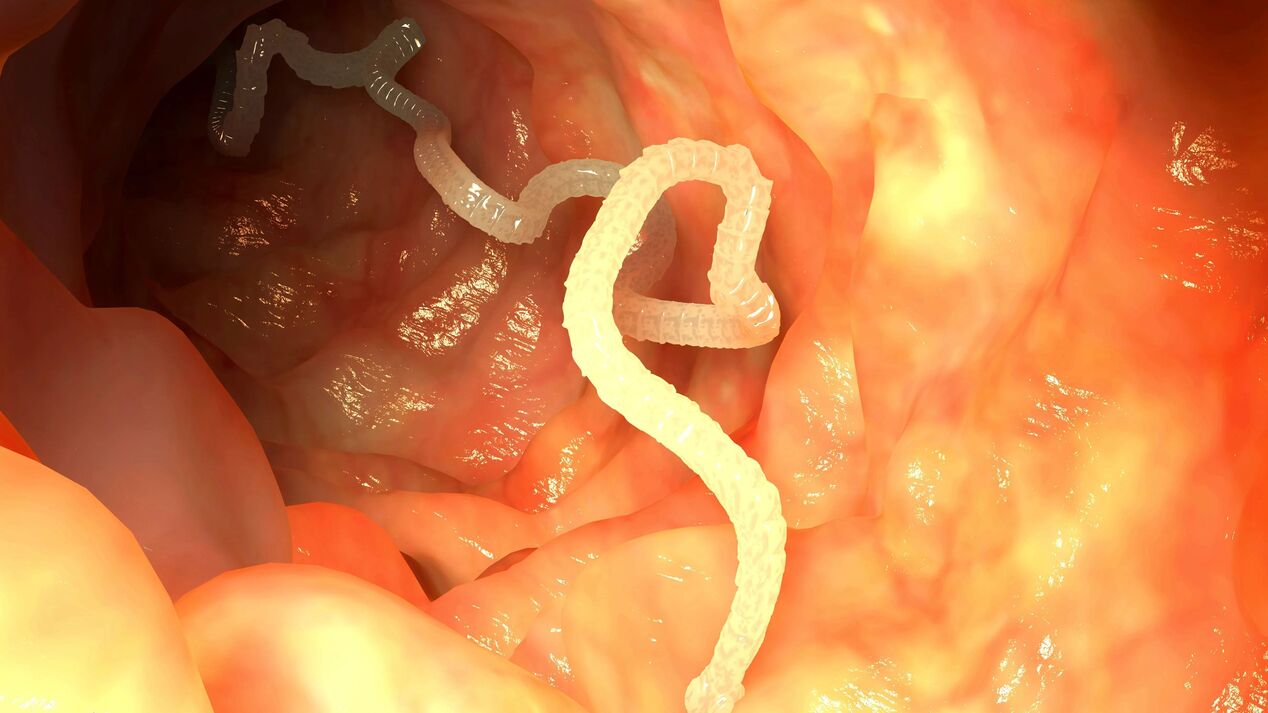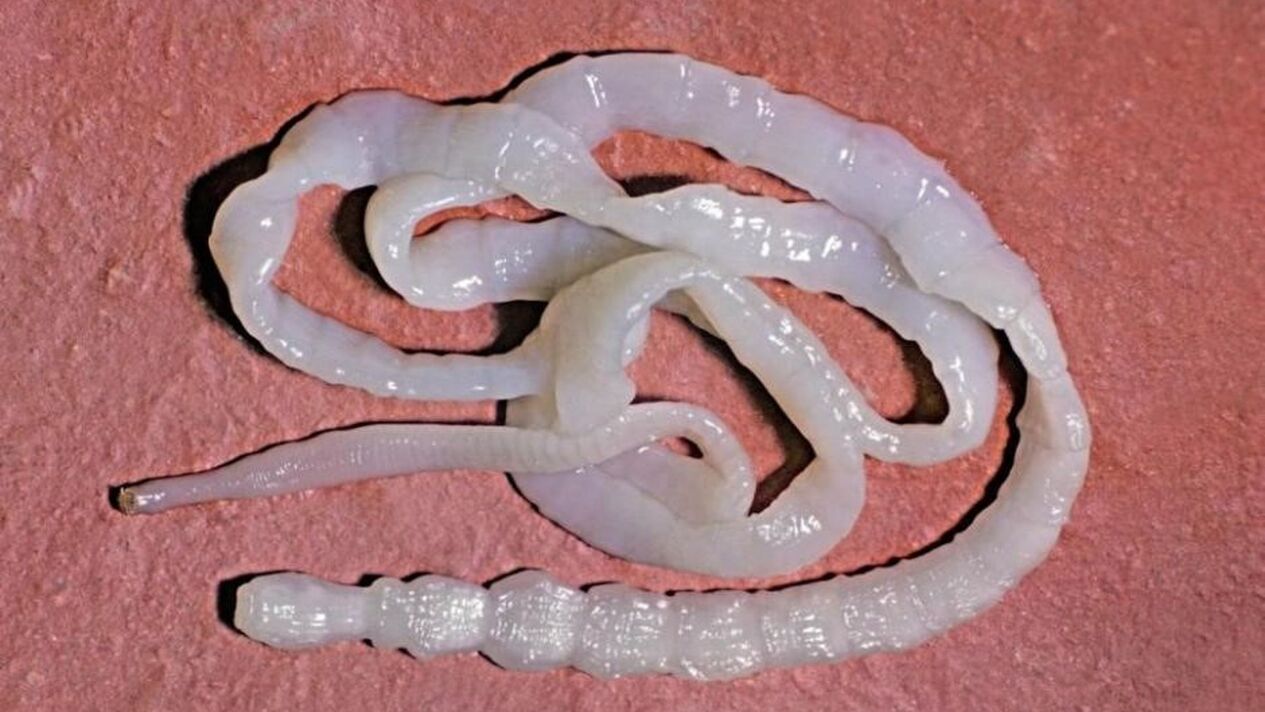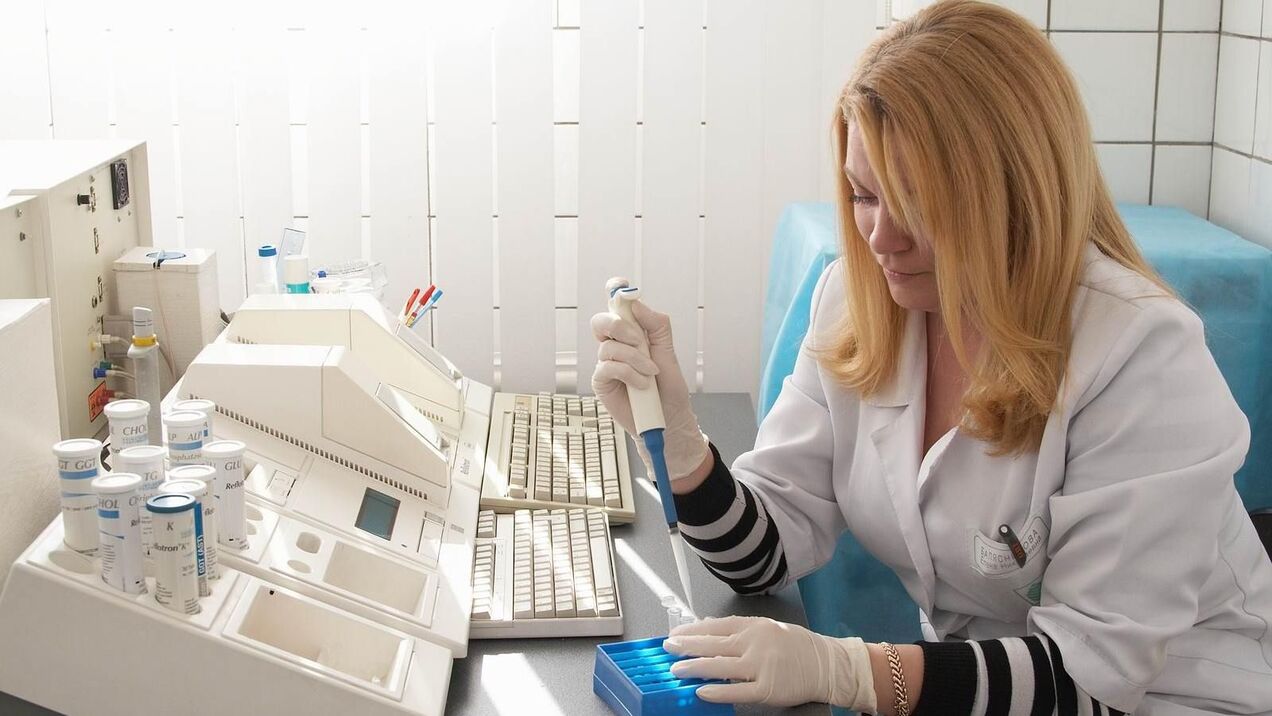
Worm infestations usually cause significant discomfort and health problems to a person. Symptoms of worms can be very diverse: fever, weakness, stomach ache, headache, etc.
Worms - what are they?

As we said above, adult worms traditionally have a stable localization in the body, and their developmental form often migrates to different organs and tissues, and often the path of movement is quite complicated. For example, with ascariasis, a person becomes infected by eating food contaminated with worm eggs (ascaris eggs ripen in the soil).
In the cavity of the intestinal tract, roundworm eggs hatch into larvae, which within a few hours pass through the wall of the intestinal tract into the blood vessels and are carried to the lungs via the bloodstream. In the lungs, roundworm larvae grow and mature. The growing larvae slowly gnaw the adjacent bronchi and crawl along them, first into the trachea, and then into the oral cavity, where they are again swallowed and carried into the intestinal tract.
Roundworm larvae that enter the intestinal tract turn into adult worms. Lung migration of roundworm larvae is indicated by many symptoms (cough, asthma attack, increased body temperature, allergic skin rash), and the presence of a small number of adult worms in the intestinal tract may not be manifested in any way.
What is helminthiasis (helminthic disease) - Symptoms of worms

The term "helminthiases" usually means some human diseases, the premise of which is a variety of parasitic worms - helminths (another collective name for these parasites - worms).
Unlike diseases caused by bacteria, protozoa, or fungi, with helminthiases, the number of adult helminths (worms) in the body of an infected person does not increase at one point (with the exception of cases of re-infection). This is due to the fact that worms reproduce only outside the human body.
What are they?
Medicine knows more than a hundred types of helminths. Here are the most common types of worms:
- Pinworms are small worms in the human body that reach a length of 12 mm. This type of worm is diagnosed in the intestinal mucosa. Parasites enter the body with dust through the respiratory tract and can be easily transmitted from person to person.
- Roundworms are large roundworms most commonly found in the small intestine. Infection of the body occurs through unwashed hands and food. More often, roundworms are found in the body of children.
- Trichinella - this parasite has a round body no more than 5 mm long and causes trichinosis in the body. Larvae and eggs prefer to be in poorly fried meat (pork, pork, bear). In the human body, Trichinella takes up to 4 days to become an adult, and its life cycle is 40 days. The main goal of this type of worm is to enter the bloodstream through the intestinal wall and settle in the muscles. In addition, the muscles of the respiratory and musculoskeletal system are often affected.
- Pig/cattle tapeworm. The length of the parasite's body is 5-6 meters, and its larvae hide in the meat of large animals (pork, beef). Diseases caused by these helminths are called taeniasis and taeniarinhoz. The larvae of both types of tapeworms are whitish vesicles that attach to the wall of the small intestine. It takes 3 months for the parasite to reach and form an adult, and the worm grows every day. The total number of segments reaches 2000, the last of which independently "shrinks" the large intestine. Then the worms leave the body with feces through the anus. The most common and obvious symptoms of helminthiasis are a disturbed digestive tract, as well as the consumption of large quantities of food, and the patient does not visually gain weight.
- Necator/worm. The relationship between these parasites is direct, due to the disease and the biological characteristics they cause. They live in the duodenum, and because of their small size (10-15 mm) they move freely in their environment. Larvae can enter the body only through the skin if a person has come into contact with contaminated soil. The next target of the worm is the lungs along with the digestive tract. They only feed on the blood that comes out of the blood vessels that are bitten. As a result of the strong activity of this parasite, blood clotting is disturbed. Adults take blood in the range of 0. 1-0. 35 ml per day.
- Echinococcus. In this case, a person acts as an intermediate host, since the final hosts are wolves, cats, and dogs. Animals can become infected through direct contact with contaminated objects or people. As soon as the parasite eggs enter the intestine, larvae with six hooks immediately develop, which in medicine are called oncospheres.
- Whipworms are diagnosed in a person's stomach. This is a thin and rather large worm.
You can determine the type of helminths by looking at what color the worms are in the stool when they appear. Infection occurs through vegetables and meat that have undergone insufficient heat treatment. You can avoid infection by following food preparation rules.
How common and dangerous are worms?
Symptoms of worms. Data from modern epidemiological studies have revealed that every 4 people worldwide are infected with worms. The incidence of worm infection is higher in children than in adults. In children and adults, worms can be a prerequisite for various diseases acquired by internal organs (gastritis, pancreatitis, enterocolitis, cholecystitis), and over time lead to the development of unsafe complications and death.
According to the Global Health Organization and the Global Disease Bank, helminthic diseases rank 4th in terms of economic harm among all other diseases and injuries.
In our region, there are more than 15 types of worms, where the most common are enterobiasis (about 90% in the group of patients with helminthic diseases), ascariasis (70%), opisthorchiasis, diphyllobothriasis, trichocephalosis (60%), toxocariasis (60%), and hymenolepiasis. As it becomes clear from the statistics, almost all sick people (especially children) are simultaneously infected with some form of worms.
Where do worms spread to humans?
Many people believe that worms definitely live in the intestines, and for some types of helminths this is true. In general, worms can be found in various organs and systems of the human body:
- all types of tapeworms, whipworms and nematodes "settle" in the large intestine;
- trematodes attack the liver and gall bladder;
- Pig tapeworm larvae can spread through the bloodstream to all organs - subcutaneous fat tissue, the eye cavity, and blood vessels in the muscles can be affected.
How can you get worms?
How do worms get into the human body? There are 4 main sources of helminth eggs entering the body:
Geohelminthiasis- through the soil (and then water) where there are mature eggs of many helminths that enter the soil with human or animal feces, as well as through direct contact with animals and through the transfer of eggs by flies to food Contact - from people to people Worms are the most famous and commonas pinworms are spread; this is the highest risk of infection.
Biohelminthiasis- when eating raw, semi-raw or slightly heated meat (pork, beef) or fish infected with helminths (sushi, kebab, dried fish, lard with streaks of meat, etc. ) Some parasites enter the body through insect bites
The main mechanism of any infection is most often oral-fecal, that is, a person simply swallows worm eggs with food, water, and less often, some helminthic attacks occur from the bite of an infected insect. Undercooked meat and raw fish are understandable, but how can you get worms through contact and household contact and through soil?
Through the ground
After any contact with soil or sand, you should not only wash your hands, but clean your nails thoroughly; it is better to have short cut nails, especially for children. Food products that grow in the ground - vegetables, herbs, fruits, berries, mushrooms, everything that is connected to the ground need a thorough washing under running water and boiling with boiling water. Pets, especially dogs and cats, walk the streets, bring a lot of sewage into the house, and children who play with them are at high risk of infection; the animal can easily infect it with any type of helminths. Flies are also the main carriers of helminths, being in public toilets, housing agricultural livestock, flies then calmly perch on food, spreading eggs on their wings and legs.
From person to person
With pinworms, infection of other people happens very easily. When the female pinworm crawls out of the intestine at night, she lays about 5, 000 eggs near the anus, which cause severe itching; The child, scratching the itchy area, attacks their hands, nails, underwear, and bed linen with them. Without washing his hands immediately, hundreds of eggs remained on all objects he touched - doorknobs, clothes, food, toys. Further, the infection process is clear; eggs also settle on the hands of children or other adults using these items, and without washing their hands before eating, they end up in the mouths of healthy people.
Through water
A large number of worm eggs end up in open water bodies and well water. Therefore, those who live in rural areas or in the country should use a bacterial filter and keep the water boiling; it is also dangerous to swallow water when swimming in open water.
Everyone knows that worms are a major problem for children. First, because they are most susceptible to the development of helminthiases, because the protective barrier in the child's body is not formed properly, and the acidity of the stomach is lower than in adults. Secondly, children of preschool age, mastering the world, try all the surrounding objects not only with their hands, but also with taste. And parents, with all their wishes, can teach their children to follow the rules of personal hygiene, without warning, only at the age of 3-6 years, which exposes not only the baby himself, but also all family members, to the risk of infection (pinworms).
It should be remembered that there are no worms that can breed and multiply in the human body, each species has its own period of time after which they die, for example, for pinworms only a few weeks, for roundworms about a year. The eggs laid by adults must leave the body either with feces, or (in the case of pinworms) on the skin near the anus, to the external environment, into the soil, and only then, after maturing outside the human body and entering it again, they begin to becomeactive and parasitic.
Symptoms of worms

The development of helminthiasis usually occurs in two stages: acute - from two, three weeks to two months and chronic - from several months to years.
The acute stage coincides with the time of introduction and development of the parasite and is manifested mainly by the immune response to foreign antigens and allergic reactions. The symptoms of this level of helminthiasis are similar when different types of parasites are introduced.
The chronic stage is distinguished by great diversity: depending on the location of the worms, their number and lifestyle, disturbances appear in the functioning of various organs and systems. By integrating into the metabolic system, consuming the necessary substances for itself, the parasite leads to disorders, manifested by digestive disorders and the absorption of vitamins, proteins, fats, carbohydrates, and minerals. Worm waste leads not only to the suppression of normal intestinal microflora, but also reduces immunity, promotes the development of chronic bacterial infections, reduces the effectiveness of preventive vaccination.
The increased risk of malignant tumors is associated with a negative effect on the immune system and an increase in the process of cell division (regeneration) in damaged tissue.
The first signs of the development of helminthiasis can appear from 2-3 days (with ascariasis) to 1. 5 years (with filariasis). Usually this period is 2-3 weeks. At the beginning of the disease, skin rashes, enlarged lymph nodes, enlarged liver and spleen, pain in muscles and joints appear. Some helminthiasis are characterized by certain signs, such as jaundice for opisthorchiasis (liver fluke) or fever, muscle pain, swelling of the face and eyelids for trichinosis.
In the chronic phase, the presence of single specimens of worms occurs practically without any symptoms, the exception may be the presence of large specimens, for example, tapeworms and roundworms. In the case of a more widespread infection, the symptoms of helminth infection consist of digestive disorders (nausea, flatulence, abdominal pain, loose stools) and some specific signs. With enterobiasis, for example, this is itching in the anus, intensifying in the evening and at night.
With trichocephalosis it is hemorrhagic colitis (with bleeding). With hookworm - iron deficiency anemia. With ascariasis, mechanical obstruction of the intestines and bile ducts may occur. With helminthiasis with liver damage, chronic hepatitis and inflammation of the bile ducts (cholecystitis, cholangitis) develop.
A special place is occupied by helminthiases with the development of cysts (formation of fluid in the membrane): echinococcosis, alveococcosis, cysticercosis. Even a large cyst may not manifest itself in any way, but its pus or rupture leads to severe consequences such as: anaphylactic shock, peritonitis, purulent pleurisy. Helminthiasis may be accompanied by symptoms of vegetative-vascular asthenia and a neurotic state. Let's consider in more detail the special case of the most common helminthiasis.
Diagnosis of worms. Worm treatment

With enterobiasis, the main conditions for successful treatment are the simultaneous deworming of all family members (or a team of children), strict hygiene measures and repeated administration of the drug 10-14 days after the first.
Folk remedies to treat worms
Traditional treatment methods include medicinal plants that have anthelmintic and laxative effects. Even in ancient times, healers recommended using elecampane and celandine juice to expel worms. Carrots and carrot juice also have an anthelmintic effect. Often in traditional medicine recipes you can find walnuts, pomegranates, mint, and more often - garlic in the form of dietary components or enemas. Wormwood decoction is used in the form of an enema or orally. Pumpkin seeds are an officially recognized medicine for worms. In folk medicine, the use of medicinal plants is often combined with salt laxatives. Although the effect of medicinal plants is not very high, they may serve as prophylaxis or addition to the traditional treatment of helminthiases.
Complications of helminthiases
Complications of helminthiasis are mainly associated with the mechanical effects of parasites on organs; tissue destruction sometimes leads to fatal dysfunction of the affected organ. The addition of bacterial infection at the site of mechanical damage is a common complication that masks the presence of parasites in the body. For susceptible people, the sight of parasites (for example, when expelled) can cause serious psychological trauma, which requires long-term rehabilitation treatment.
Prevention of worms
Contains timely identification and treatment of sick people and animals, compliance with personal hygiene measures (washing hands before eating, thoroughly washing food products, careful heat treatment of food, especially meat and fish).
Frequently asked questions
What symptoms may indicate the presence of worms in a person?
Symptoms of worms may include persistent fatigue, loss of appetite, weight loss, abdominal pain, itching in the anal area, and digestive problems such as diarrhea or constipation.
How can you tell if someone has worms?
To determine the presence of worms in a person, you can do a stool test for worm eggs or do a blood test for the presence of antibodies against worms. The doctor may also prescribe ultrasound or other diagnostic procedures to confirm the diagnosis.
What precautions can be taken to prevent worm infection?
To prevent worm infection, it is recommended to wash your hands frequently with soap and water, especially before eating and after using the toilet. You should also avoid contact with contaminated soil or water, drink only clean drinking water, and cook food properly to destroy any possible worm eggs.
Useful tips
Tip #1
Pay attention to changes in appetite and weight. If you or your child experiences constant hunger or, conversely, loss of appetite, this may be a sign of helminthic infection.
Tip #2
Pay attention to the condition of your skin and hair. If you or your child has a rash, itching, or changes in hair texture (such as brittleness or hair loss), it may be due to the presence of worms.
Tip #3
Pay attention to the function of the gastrointestinal tract. If you or your child has frequent stomach aches, constipation or diarrhea, this may be due to a worm infection.



























